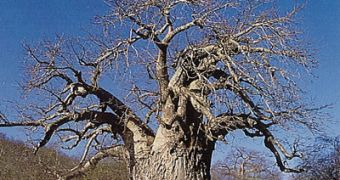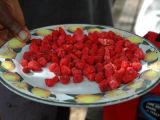David Livingstone said about this tree that "it's like a carrot planted upside down".
The baobab (Adansonia digitata) is named after the first explorer who discovered it, Michel Adanson, in 1749 in Senegal. There are 6 baobabs living in Madagascar, 1 in African savanna and 1 in the Australian savanna, like a proof of the existence in the past of just one southern continent, Gondwana.
The baobab is an enormous tree, but not due to its height: it reaches a maximum of 31.2 m (104 ft), but to its thickness: the trunk can be 11 m (38 ft) in diameter while the diameter of the canopy can be 100 m (333 ft), covering 6-7,000 square meters. The gray bark can be 5-10 cm (2-4 inches) thick. But the roots of the tree are extremely large: up to 50 m (166 ft) long.
During the dry season (up to seven months) the tree is devoid of leaves. In the short rainy season, the spongy fibers of the tree adsorb a great quantity of water kept by the tree during the dry season. The upper part of the trunk is usually hollow, inside it being stored rainfall and dew, this being the only water source on miles around. A tree, which has 200 cubic meters can contain up to 140,000 liters of water. If small trunk pieces are cut, water can be squeezed from them.
Baobabs are supposed to live over 1,000 years, but no research has been made on this direction.
The wood of the baobab is too wet to be used for the fire, but the bark is employed for making ropes, nets, mats, fabrics, hats, canoes, trays, boxes, baskets, fishing suber and for processing paper. The wood is extremely porous and light.
The ash of the bark can be employed as fertilizer and for making soap. Young soft shoots and acacia-like leaves are eaten. The red acid baobab seeds are eaten as sweets. Toasted seeds are used as coffee surrogate.
The seeds' white and acidulated pulp (rich in vitamin C and B1 and calcium) is used for making beer but also oil can be extracted from it. The pulp can also be used as surrogate for cooking powder.
Beverages made from the pulp are refreshing, having lemon-like flavor and by burning the pulp, mosquitoes are chased away. Pulp mixed with milk gives a type of local yoghurt.
During the rainy season, the tree makes beautiful white flowers, up to 30 cm (0.9 ft) long, which stink like rotten meat! The flowers bloom during the night as they are pollinated by fruit-eating bats.
The pollen mixed with water is used as adhesive. The 40 cm (1.3 ft) long fruit has a long peduncle and velvet touch, looking like a monkey tail or, for others like huge cucumbers. It is extremely appreciated by monkeys, too, that's why the baobab is also called "monkeys' bread tree".
The tree has also curative qualities.
Breastfeeding mothers mix the fruit's pulp like a powder with their milk, which protects against colics, dysentery and fever.
Different parts of the tree are used against inflammations, tooth and various pains, anemia, diarrhea, flue, asthma, renal and respiratory conditions and even against tumors. Boiled leaves are used in a decoction against malaria.
Not only the African people, but Australian Aborigines too have exploited the baobab.

 14 DAY TRIAL //
14 DAY TRIAL // 
